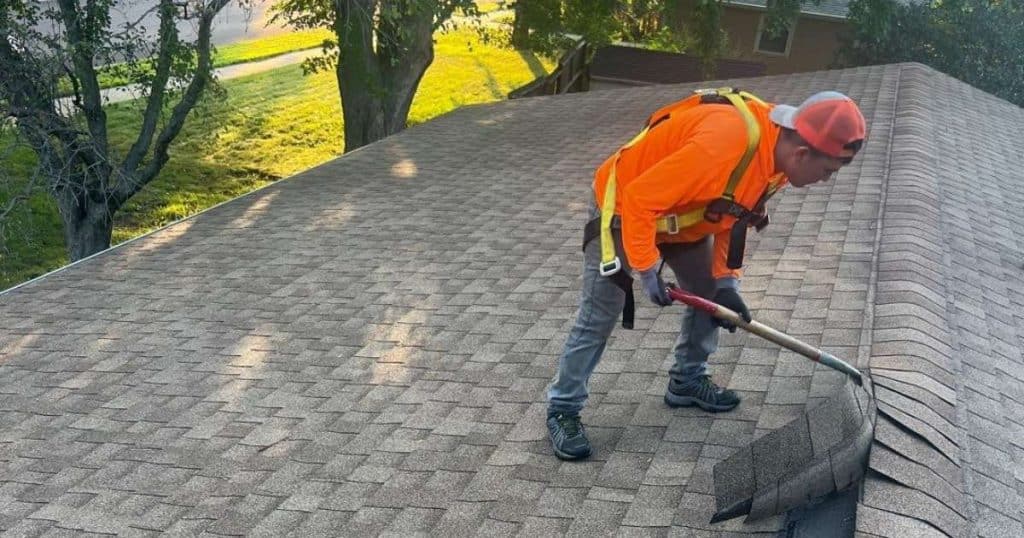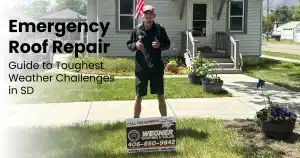____________________________________________________________________________
When a roof emergency strikes, the safety and integrity of your home are at immediate risk.
Imagine this: you’re enjoying a peaceful evening at home in Rapid City when a severe storm strikes out of nowhere. The wind howls, rain pours down in torrents, and suddenly, you hear it—a loud crash followed by the unmistakable sound of water dripping inside your house.
Your roof has been damaged, and you realize you’re facing a serious roof problem that can’t wait.
This is the moment you need an emergency roof repair guide to help you navigate the situation, ensuring your home is safe and secure.
What Is a Roof Repair Emergency?
Understanding the Severity of Roof Problems
A roof repair emergency occurs when damage to your roof compromises the safety of your home or its occupants. Common examples include severe leaks, structural damage from fallen trees, or fire damage. These situations require immediate attention to prevent further damage, protect the interior of your home, and ensure the safety of everyone inside.
Roof emergencies can manifest in several forms, ranging from minor issues that require prompt attention to severe cases that demand immediate intervention. Knowing how to recognize a roof repair emergency is crucial for minimizing damage and avoiding costly repairs.
Types of Emergency Damage
Tree Damage
Tree damage is one of the most common causes of emergency roof repairs. In South Dakota, storms can cause trees to fall, leading to significant roof damage. Whether it’s a large branch or an entire tree, the impact can create holes in the roof or even cause structural collapse.
Fire Damage
Fire damage to a roof is a severe emergency that requires immediate attention. Even if the fire is contained quickly, the heat and flames can weaken the roof’s structure, making it unstable and dangerous.
Superficial Hail Damage
Hailstorms are common in Sioux Falls and can cause superficial hail damage to your roof. While this type of damage may seem minor, it can lead to leaks and other issues if not addressed promptly.
Minor Flashing Damage
Flashing damage, though often minor, can quickly escalate into a serious roof problem. Flashing is essential for directing water away from critical areas of the roof, and any damage to it can result in leaks.
Moss or Algae Growth
Moss or algae growth might not seem like an emergency at first, but it can lead to significant roof damage over time. Moss can trap moisture against the roof surface, leading to rot and decay, which could eventually cause a roof collapse.
Common Roof Problems That Require Emergency Repairs

Several common roof problems can quickly escalate into emergencies if not addressed promptly. Understanding these issues can help you take swift action and minimize damage to your home.
Leaks and Water Intrusion
- Leaks are among the most common roof problems that necessitate emergency repairs. Water intrusion can cause widespread damage, including rotting wood, mold growth, and structural weakening. Immediate action is essential to prevent long-term damage.
- Prevention Tip: Regular roof inspections, especially after storms, can help identify and repair minor issues before they turn into major leaks. In Sioux Falls, where storms are frequent, this can be a critical step in maintaining your roof’s integrity.
Structural Damage
- Roofs can suffer structural damage from heavy snow loads, falling trees, or severe storms. Structural damage is particularly dangerous as it can lead to a partial or total collapse of the roof, posing significant risks to the occupants.
- Prevention Tip: Ensure that your roof is built to withstand local weather conditions. In areas like Spear Fish, where snowfall can be heavy, reinforcing your roof’s structure may prevent future emergencies.
Wind Damage
- High winds can cause significant damage to roofs, especially in exposed areas like Rapid City. Winds can lift shingles, break tiles, and even remove entire sections of the roof. This type of damage often requires immediate repairs to prevent further exposure to the elements.
- Prevention Tip: Use high-quality, wind-resistant materials when replacing or installing a roof. Regularly inspect your roof after high winds to catch any damage early
Emergency Roof Leak Repairs
Dealing with Sudden Leaks
Roof leaks are one of the most common reasons for emergency roof repairs. Whether caused by storm damage, flashing issues, or roof deterioration, leaks can lead to severe water damage if not addressed immediately. The first step is to locate the source of the leak and contain the water to prevent further damage.
When to Call a Professional
It’s important to know when to call a professional for emergency roof leak repairs. While minor leaks might seem manageable, attempting to repair them yourself could result in further damage or even injury. A professional roofer can assess the situation accurately and provide the necessary repairs to prevent the problem from worsening.
Emergency Roof Repair Steps
Assess the Damage
Before taking any action, assess the extent of the roof damage. Check for visible signs such as missing shingles, holes, or structural damage. If the damage is severe, such as a large hole or tree impact, it’s crucial to call a professional immediately.
Temporary Patching
If it’s safe to do so, you can apply a temporary patch to prevent water from entering your home. Use a tarp or roofing tape to cover the damaged area until a professional roofer can perform permanent repairs.
Contact a Professional Roofer
Contact a professional roofer as soon as possible to handle the emergency repair. In Rapid City, Sioux Falls, or Spearfish, many roofers offer emergency services to address urgent roof problems.
Document the Damage
Documenting the damage with photos can be helpful for insurance purposes. Ensure you have a record of the initial damage and any temporary measures you’ve taken.
What to Do During a Roof Emergency
When faced with a roof emergency, it’s essential to act quickly to minimize damage and ensure the safety of your home’s occupants. Here’s what to do:
- Ensure Safety: Make sure everyone inside the home is safe. If the damage is severe, such as structural collapse or fire damage, evacuate the premises immediately.
- Contain Water Damage: If the emergency involves a leak, use buckets, tarps, or other materials to contain the water and prevent it from spreading.
- Turn Off Electricity: In the case of severe leaks or flooding, turn off the electricity to prevent electrical hazards.
- Contact a Roofer: Call an emergency roofing service to address the damage promptly.
Preventing Future Roof Emergencies
Routine Inspections and Maintenance
Regular roof inspections and maintenance are essential for preventing emergencies. By identifying potential problems early, such as moss or algae growth, you can address them before they escalate into severe damage.
Investing in Quality Materials
Investing in quality roofing materials can also help prevent future emergencies. Durable materials can withstand harsh weather conditions common in South Dakota, reducing the likelihood of roof damage during storms.
Addressing Minor Issues Promptly
Addressing minor issues like flashing damage or superficial hail damage promptly can prevent them from developing into larger problems. Regularly check your roof for signs of wear and tear and address any issues immediately.
For more information on roof types that can withstand extreme weather conditions, you might want to read our previous blog, Pros and Cons of Modified Bitumen Roofing.
Following this emergency roof repair guide can save you time, money, and stress when dealing with roof problems in South Dakota. Whether you’re in Rapid City, Sioux Falls, or Spearfish, knowing how to respond to roof emergencies ensures that your home remains safe and secure.
FAQs
Is a hole in the roof an emergency?
Yes, a hole in the roof is considered an emergency because it exposes your home to the elements, leading to potential water damage, structural issues, and safety hazards.
How do you emergency patch a roof?
To emergency patch a roof, use a tarp, roofing tape, or temporary shingles to cover the damaged area. This should only be a temporary solution until a professional can provide permanent repairs.
Can you repair just a section of a roof?
Yes, you can repair just a section of a roof, but this depends on the extent of the damage. A professional roofer can assess whether a partial repair is sufficient or if more extensive work is needed.



